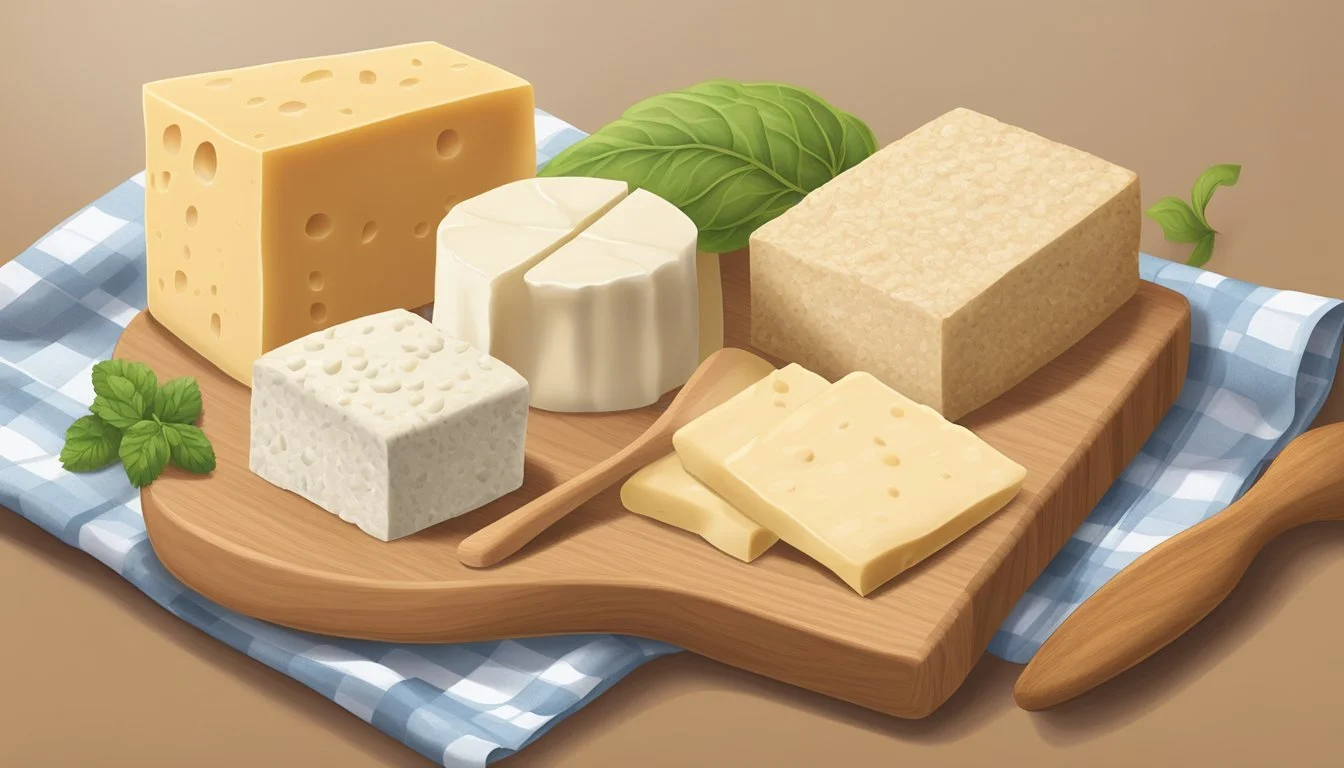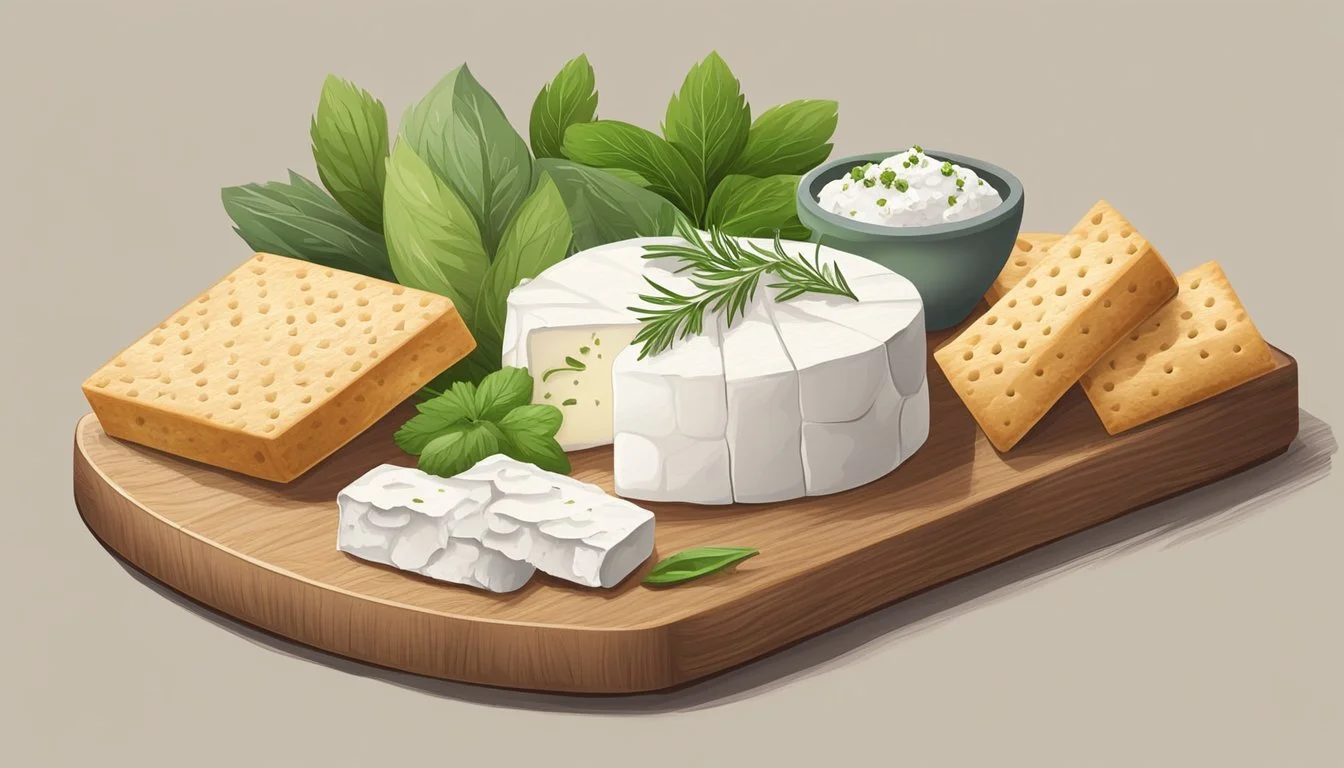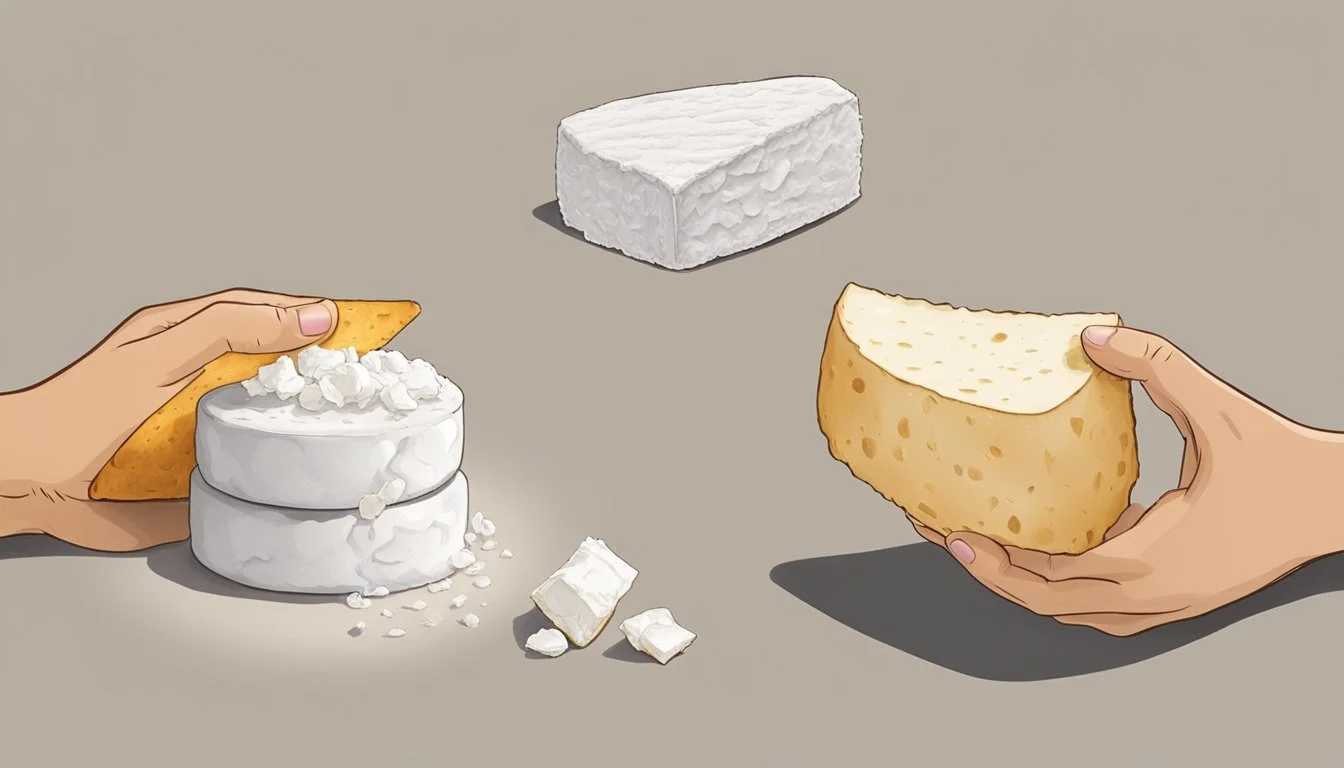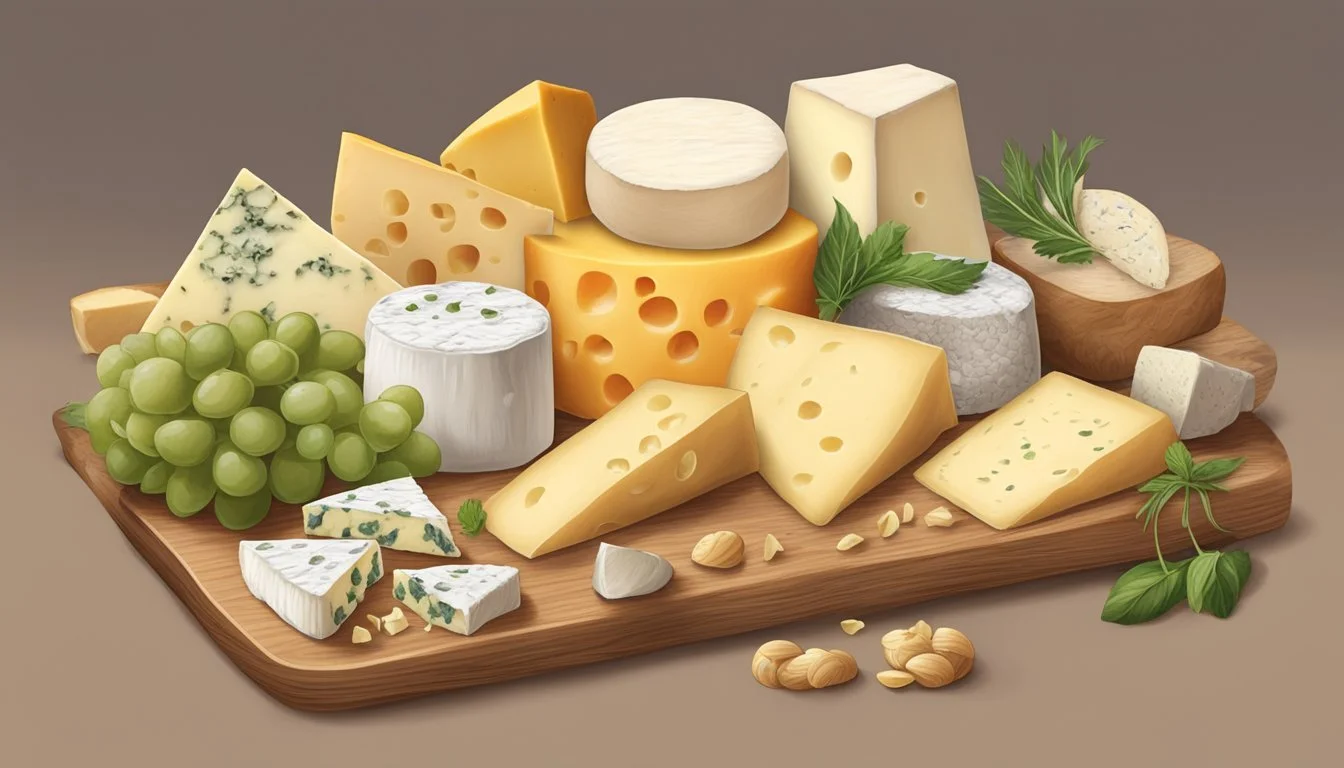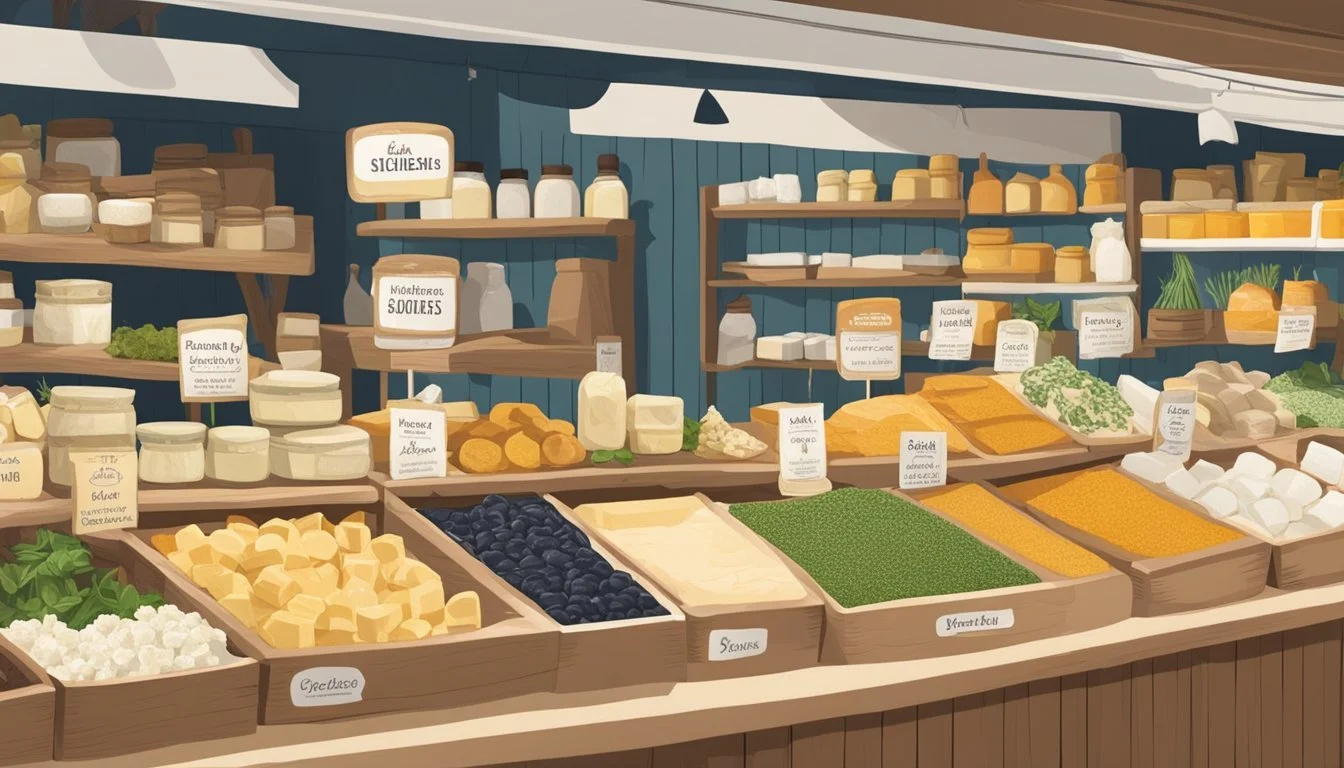Goat Cheese Substitutes
Top Alternatives for Your Recipes
Goat cheese (What wine goes well with cheese?), with its distinct tangy flavor and creamy texture, has become a beloved staple in culinary cultures across the globe. Recognized for its versatility, it graces dishes from salads and spreads to baked goods and sauces. However, the use of goat cheese may not be suitable for everyone, whether due to dietary restrictions, taste preferences, or simply due to availability issues. As a result, there is a growing need for reliable goat cheese substitutes that can mimic its unique characteristics without compromising on taste or functionality in recipes.
When looking for a goat cheese alternative, one must consider both the flavor and texture that goat cheese brings to a dish. Substitutes can range from other dairy products like feta, which provides a similar salty and tangy profile, to non-dairy options such as tofu-based cheeses that offer a different nutritional profile but still lend the desired creamy consistency. For a richer, more indulgent profile, some might suggest cream cheese or even a matured cheese like Camembert, which, while more pungent, can adapt to recipes typically calling for goat cheese.
Understanding Goat Cheese
Goat cheese is a distinctive dairy product with unique attributes and a variety of uses in culinary traditions. Exploring its characteristics, nutritional benefits, and culinary applications provides insight into its popularity.
Characteristics of Goat Cheese
Goat cheese, produced from goat’s milk, encompasses a range of flavors and textures that can vary depending on its preparation and aging process. Fresh goat cheese typically has a tangy, earthy flavor that can be mild or robust. The cheese often comes in a soft, spreadable form, but can also be aged and made firmer.
Flavor: Often described as tangy and more savory compared to cow's milk cheeses.
Texture: Ranges from creamy and soft to crumbly and dense.
Nutritional Profile
Goat cheese is appreciated not only for its taste but also for its nutritional content. It contains protein, essential for building and repairing tissues, and is a good source of calcium and phosphorus, vital minerals for bone health. Goat cheese generally contains less lactose than cow's milk cheese, which can make it easier to digest for some individuals. It is also rich in Vitamin B, important for metabolic processes. However, goat cheese has a fat content that should be consumed in moderation.
Nutritional Values per 100g of Goat Cheese:
Calories: 364
Protein: 22g
Fat: 30g
Calcium: 140mg
Phosphorus: 360mg
Vitamin B2: 0.52mg
Culinary Uses
Goat cheese is versatile in the kitchen, suitable both for fresh applications such as salads and sandwiches and for cooking in dishes like pastas and tarts. Its ability to complement a variety of ingredients, from fruits to herbs, makes it a favorable choice for chefs and home cooks alike.
Commonly used as a topping for salads and pizzas.
Often incorporated into sauces to add creaminess without overpowering the dish.
Can be baked into pastries or served with fruit as a dessert.
Goat Cheese in Cooking
Goat cheese is renowned for its distinct tangy flavor, crumbly texture, and versatility in cooking. It easily integrates with various dishes across multiple cuisines, commonly appearing in salads, pasta dishes (What wine goes well with pasta dishes?), pizzas, and sauces.
Cheese in Salads
In salads, goat cheese adds a creamy texture and robust flavor that pairs well with leafy greens and vinaigrettes. It's especially favored in Mediterranean salads where its tartness complements the flavors of olive oil and balsamic vinegar. Crumbling goat cheese atop salads is a simple way to elevate the dish's overall taste profile.
Cheese in Pasta Dishes
For pasta dishes, goat cheese can be melted into sauces to create a rich and creamy consistency without overpowering other ingredients. It can also be crumbled on top as a garnish, imparting a salty note that contrasts nicely with the natural sweetness of tomato-based sauces or the earthiness of pesto.
Cheese on Pizza
Goat cheese on pizza adds a level of sophistication with its delicate, tangy notes that cut through the richness of other toppings like caramelized onions and robust meats. Its meltability isn't as pronounced as mozzarella, but it offers a delightful creaminess that enhances the overall flavor of the pizza.
Cheese in Sauces
In sauces, goat cheese serves as a thickening agent while contributing a luxurious creamy texture. Chefs may incorporate it into creamy pasta sauces or even bold, spicy sauces where its tang can provide a counterbalance to heat. One can integrate goat cheese into a sauce smoothly by warming it gently, allowing for even distribution throughout the concoction.
Using goat cheese in cooking thus extends its utility beyond just being a stand-alone cheese, proving it to be an adaptable and acclaimed player in the culinary world.
Popular Goat Cheese Substitutes
Finding a suitable goat cheese substitute can be straightforward when one knows the alternatives that best mimic the characteristics of goat cheese. Depending on the intended use, some alternatives perform better in cooking, while others are more suitable for fresh consumption.
Substitutes for Cooking
When cooking, substitutes should complement the dish’s texture and flavor profile. Two highly recommended options include:
Ricotta Cheese: Often chosen for its low-fat content, ricotta cheese has a creamy texture that blends well in recipes such as lasagna, cheesecake, or soups. Its mild taste can be enhanced with a pinch of salt.
Substitute Texture Flavor Ricotta Smooth and creamy Mild, adaptable
Mozzarella: Known for its excellent melting quality, mozzarella can be used in dishes requiring a smooth, meltable cheese. Mozzarella has a delicate flavor, making it a versatile cheese for cooking.
Substitute Texture Flavor Mozzarella Soft, meltable Delicate
Substitutes for Fresh Consumption
For fresh consumption, like in salads or as a spread, alternatives should aim for a similar fresh and tangy profile. Suitable substitutes include:
Cream Cheese: A common swap for goat cheese, cream cheese is rich and spreads well on crackers and bread, making it ideal for dips or as part of appetizers.
Substitute Texture Flavor Cream Cheese Creamy, spreadable Rich
Feta Cheese: With its salty and tangy taste, feta cheese, especially made from sheep's milk, comes close to the distinct flavor of goat cheese and can be crumbled over salads.
Substitute Texture Flavor Feta Crumbly Salty, tangy
Readers can confidently choose from these alternatives depending on their cooking needs or when they simply want a cheese that can be enjoyed fresh. The substitutes listed not only imitate the traits of goat cheese but also offer varied characteristics that can suit different personal preferences and dietary requirements.
Dairy-Based Substitutes
When choosing a dairy-based substitute for goat cheese, one should consider the texture and flavor profile they wish to emulate. From creamy spreads to crumbly options, dairy alternatives offer a range of consistencies and tastes that can closely match the characteristics of goat cheese in various recipes.
Cream Cheese as a Substitute
Cream Cheese can provide a smooth, creamy texture ideal for spreading on crackers or blending into sauces. It offers a mild taste that is easily adaptable to recipes calling for goat cheese. To enhance the flavor to be more goat cheese-like, one may blend Greek yogurt or labneh with cream cheese to add tartness.
Feta Cheese Alternatives
Feta Cheese, made traditionally from sheep's milk or a mixture of sheep's and goat's milk, presents a tangy and salty flavor. The crumbly texture of feta makes it an excellent alternative for salads or baked dishes. For a milder variant, Cow’s Milk Feta provides a less intense flavor while keeping a similar texture.
Ricotta and Mascarpone Options
Both Ricotta Cheese and Mascarpone are Italian cheeses with subtle flavors. Ricotta offers a grainier texture, akin to goat cheese when crumbled. It’s also lower in fat, making it suitable for healthier recipes. Mascarpone has a creamier, richer profile, which works well in desserts (What wine goes well with desserts?) or as a spread.
Ricotta Cheese: Good for crumbled goat cheese substitutions.
Mascarpone: Ideal for recipes requiring creamy goat cheese.
Exploring Blue Cheese and Camembert
Blue Cheese possesses a distinct sharpness with a creamy yet crumbly texture, comparable to soft goat cheese varieties. It’s an assertive flavor that can stand in for goat cheese in dressings and dips. Camembert is another worthy substitute; its soft, buttery nature and edible rind might appeal to those who enjoy the creaminess of certain goat cheeses.
Blue Cheese: Bold, sharp flavor suitable for dips.
Camembert: Creamy, buttery, with an edible rind.
Plant-Based and Vegan Substitutes
For those who are vegan or lactose intolerant, finding a substitute for goat cheese that aligns with dietary restrictions is crucial. Alternative products made from plant-based sources provide a versatile and accessible option for those avoiding dairy.
Tofu-Based Alternatives
Tofu, derived from soy milk, stands out as a prominent non-dairy substitute for goat cheese. Its malleable texture allows it to be used in various culinary applications. When crumbled, firm tofu can mimic the texture of goat cheese, providing an excellent addition to salads and as a topping.
For spreads, silken tofu combined with lemon juice and a touch of salt offers a creamy consistency similar to soft goat cheese. A sprinkle of nutritional yeast can add a cheesy flavor, enhancing the tofu's ability to replicate the tanginess of goat cheese.
Preparation Tips for Tofu-Based Goat Cheese:
Crumble firm tofu for a goat cheese-like texture.
Blend silken tofu with lemon juice and salt for a spreadable version.
Nutritional yeast can be added for a cheesy, tangy flavor profile.
Nutritional Yeast and Vegan Cheeses
Nutritional yeast is a deactivated yeast product commonly used to add a cheesy, nutty flavor to vegan dishes. It is rich in B-vitamins and can be an important nutritional component in a vegan diet. By incorporating nutritional yeast, one can create homemade vegan cheeses that resemble the flavor profile of goat cheese.
Vegan cheese varieties, particularly ones made from nuts like cashews, have grown in popularity. Cashew cheese is often favored for its rich, creamy texture and versatility. Easily flavored with additional ingredients such as herbs and spices, cashew cheese is a valuable asset for plant-based cooking.
Nutritional Yeast: Adds a tangy, cheesy taste to vegan cheese recipes.
Cashew Cheese: A staple in vegan kitchens for its creamy texture and adaptability.
Sprinkle over dishes as a flavor enhancer.
Mix into sauces and spreads to create a cheesy taste.
Cashew Cheese Making Basics:
Soak cashews to soften.
Blend with water, lemon juice, nutritional yeast, and salt until smooth.
Refrigerate to allow the flavors to develop and the cheese to firm up.
Goat Cheese Substitute Application
When looking for goat cheese substitutes, one should consider how these alternatives can seamlessly fit into various types of dishes, from savory appetizers to indulgent desserts. The key qualities to replicate are goat cheese's distinct tangy flavor, sometimes a mild flavor profile, and its creamy texture, and this can vary based on the application within goat cheese recipes.
Substitutes in Appetizers
In appetizers, one aims to mimic goat cheese's creamy texture and its ability to enhance flavors without overpowering other ingredients. Cream cheese is an excellent substitute due to its richness and versatility. A blend of cream cheese with a pinch of lemon juice can add a tangy flavor similar to goat cheese and works well in stuffed mushrooms or canapés.
Substitutes in Main Courses
When it comes to main courses, the substitute should complement the primary ingredients without altering the dish's intended taste profile. Ricotta cheese serves as a suitable replacement, particularly in baked pasta dishes, due to its mild flavor and looser consistency than goat cheese. To achieve a conversion closer to the original recipe, one might add a bit of salt to enhance the flavor.
Substitutes in Desserts
For desserts like the classic Italian tiramisu, mascarpone is an excellent alternative due to its smooth, creamy texture and mild flavor that doesn't distract from the dessert's delicate balance. When one requires a lighter option, ricotta can be a good fit, complementing the dessert with its subtle sweetness and graininess, which is similar to the consistency of traditional goat cheese when used in cheesecakes or sweet tarts.
Non-Dairy and Lactose-Free Options
For individuals seeking non-dairy or lactose-free alternatives to goat cheese, certain options can provide the texture and flavor profiles desired. These options are especially beneficial for those who are lactose intolerant or following a dairy-free diet.
Yogurt and Greek Yogurt Substitutes
Yogurt substitutes can mimic the creamy texture and mild tanginess of goat cheese. Non-dairy varieties are typically made from plant-based milks such as almond, soy, or coconut. Each type brings a unique flavor:
Almond milk yogurt: Mild with a slight nuttiness.
Soy milk yogurt: Richer in protein, closer to Greek yogurt in texture.
Coconut milk yogurt: Offers a tropical hint with a lighter consistency.
When substituting for goat cheese in recipes, one should note that plant-based yogurts often have a smoother texture, so it may be beneficial to drain them for a thicker, cheese-like consistency.
Exploring Cottage and Cotija Cheese
Cottage cheese and Cotija cheese are dairy-based however, non-dairy versions of cottage cheese can be made using tofu as a base. It provides a similar chunky texture and can be seasoned to enhance its flavor:
Texture: Crumbly and soft.
Use: Salads, spreads, and as a filling.
Cotija cheese, a hard cow's milk cheese from Mexico, offers a salty flavor similar to goat cheese.
For those avoiding dairy:
Non-dairy Cotija alternatives can be homemade with nuts like almonds or cashews, blended with nutritional yeast and seasonings for a similar salty flavor and crumbly texture.
Handling and Storage of Substitutes
When selecting a substitute for goat cheese, one should pay attention to proper handling and storage to retain the quality and safety of the product. Here are the best practices for handling and storage:
Cream Cheese and Ricotta:
Refrigerator Storage: These should be stored in the refrigerator at or below 40°F.
Sealed Containers: Keep them in original packaging or airtight containers to prevent drying out.
Shelf Life: Typically, they last about two weeks after opening.
Brine Storage: If purchased in brine, store it in the brine within the refrigerator.
Dry Storage: Store in an airtight container if brine is not available.
Expiry Check: It generally lasts up to a week after the "sell by" date if stored properly.
Temperature: Keep mozzarella refrigerated.
Moisture Control: Store in a container with a paper towel to absorb excess moisture.
Usage: Fresh mozzarella should be consumed within a few days of opening.
Halloumi and Parmesan:
Cool Conditions: Store these cheeses in the cooler sections of the refrigerator.
Wrap Right: Use wax paper or cheese paper followed by plastic wrap to maintain quality.
Longevity: These can be stored for several weeks.
Across all substitutes, one should always watch for signs of spoilage such as mold growth or off odors and discard any cheese that shows signs of deterioration. It is also important to handle these products with clean utensils to prevent cross-contamination. Proper storage ensures the longevity, taste, and safety of these goat cheese substitutes.
Health and Nutrition Considerations
When considering goat cheese substitutes from a health and nutrition perspective, it is crucial to compare the fat content, caloric values, protein and nutrient density, and benefits for gut health provided by the various alternatives.
Fat Content and Caloric Comparison
Goat cheese is known for its moderately high-fat content and caloric count which can be a concern for some individuals. Feta cheese, a common substitute, shares a similar caloric and fat profile but can be slightly higher in sodium content, making it necessary to balance intake. On the other hand, ricotta cheese tends to have a lower fat percentage, especially in its part-skim variations, providing a leaner option. Cream cheese features a higher fat level and can be more calorie-dense, implying cautious consumption for individuals monitoring their caloric intake.
Protein and Nutrient Density
Substitutes for goat cheese differ in their protein content and overall nutrient density. Mozzarella, for example, is generally rich in protein, aiding in muscle repair and growth. Ricotta cheese contributes less protein per serving compared to goat cheese but still offers a useful amount of essential amino acids. Parmesan cheese, while used in smaller quantities due to its strong flavor, is dense with nutrients including calcium and phosphorus, beneficial for bone health.
Benefits for Gut Health
Goat cheese contains probiotics that are key to maintaining a healthy gut microbiome. Substitutes like fermented feta carry similar probiotic qualities, potentially offering gut health benefits. Consumers searching for lower-fat options with some gut health advantages may opt for ricotta or mascarpone, though their probiotic profiles may not be as pronounced as goat cheese. Regular consumption of these cheeses in moderation can support digestive health and contribute to a balanced diet.
Exploring Cheese Varieties
When considering goat cheese substitutes, it's essential to look at both texture and flavor. One can find suitable alternatives in diverse European cheeses, often based on sheep milk, and in the characteristics distinguishing fresh from aged cheeses.
European Varieties like Manchego and Pecorino
Manchego originates from Spain and is made exclusively from sheep's milk. This cheese is known for its firm texture and can range from mildly to intensely nutty and savory, depending on its age. Pecorino Romano, a hard Italian cheese also from sheep's milk, offers a sharp and salty flavor profile, making it another excellent substitute, especially when grated over dishes in lieu of goat cheese.
Flavor: Intensely nutty (Manchego) | Sharp and salty (Pecorino Romano)
Origin: Spain (Manchego) | Italy (Pecorino Romano)
Milk Source: Sheep
Consistency: Firm for Manchego, especially aged varieties; Hard and crumbly for Pecorino Romano
Fresh and Aged Cheese Perspectives
In the context of fresh cheeses, queso fresco is a mild, soft, and creamy cheese from cow's milk and sometimes from a combination of cow and goat or sheep milk. It brings a light and tangy note to dishes. Whereas, aged cheeses like queso añejo, which is the aged version of queso fresco, present more assertive flavors and firmer textures which can stand in for aged goat cheeses.
For a cheese with a unique texture and taste, halloumi from Cyprus can be a commendable stand-in for firmer goat cheeses. Due to its high melting point, halloumi can be grilled or fried, offering a crispy outer layer and a chewy interior with a salty kick.
Fresh Cheese: Queso fresco | Creamy, mild, tangy
Aged Cheese: Queso añejo | Assertive, firm
Unconventional: Halloumi | Grilled or fried, crispy and chewy, salty
Cultural and Regional Influences
In the vast landscape of culinary arts, cheese plays a pivotal role. The Mediterranean region is renowned for its diverse dairy products, while various regions in America offer their own unique cheese alternatives suitable for a charcuterie (What wine goes well with charcuterie?) board or other culinary uses.
Cheese in Mediterranean Cuisines
The Mediterranean basin is a cornucopia of cheese varieties, with each country boasting its own signature dairy product. For instance, French cheese like Roquefort and Boursault have distinct characteristics and flavors molded by cultural practices and geography. These cheeses not only feature prominently in local cuisine but also inspire cheese selections and substitutions around the world. When seeking a substitute for goat cheese, culinary traditions often turn to other soft, flavorful Mediterranean cheeses that complement the regional dishes.
Regional American Cheese Alternatives
In America, the landscape of regional dairy products mirrors the diversity found in the Mediterranean. When it comes to alternatives to goat cheese, each region offers unique types of cheese that can be used on a charcuterie board or in various recipes. For instance:
Northeast: Creamy cheeses like Havarti or Monterey Jack serve as excellent substitutes, meshing well with a variety of flavors.
Southwest: Pepper Jack adds a spicy twist, embodying the bold flavors of the region.
The American cheese repertoire stands as a testament to the inventiveness and adaptability of modern cheese-making, creating alternatives that respect both the cultural origins of a dish and the palette of the region.

